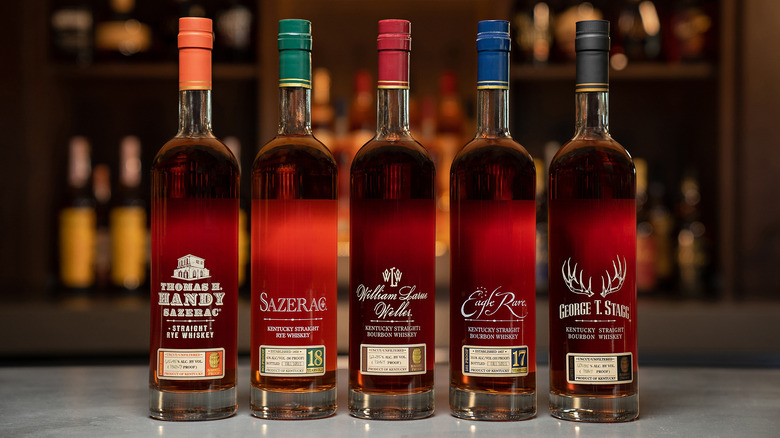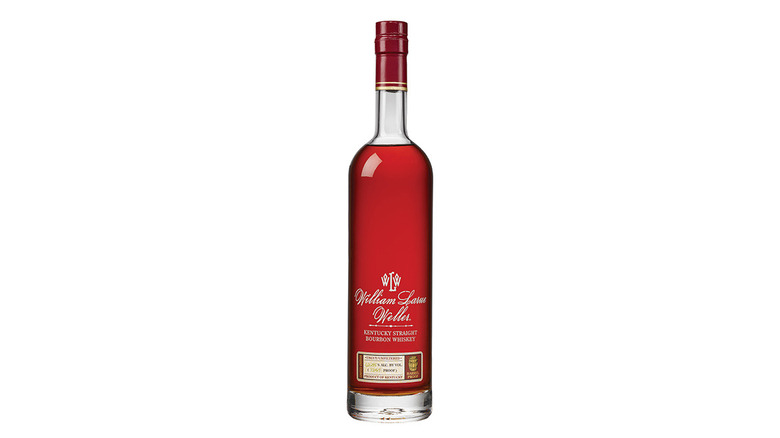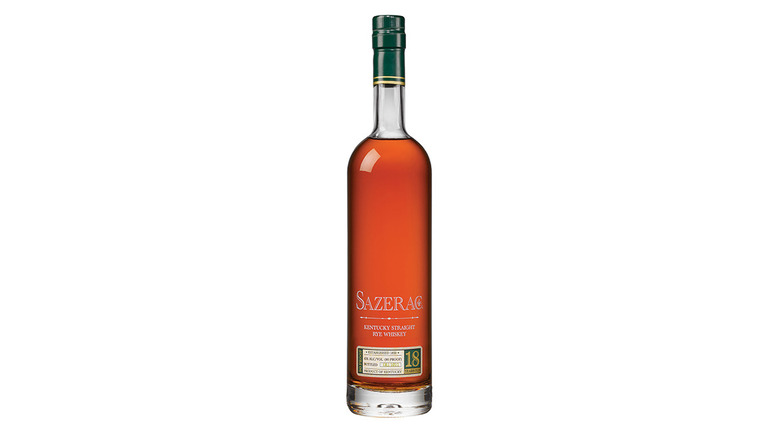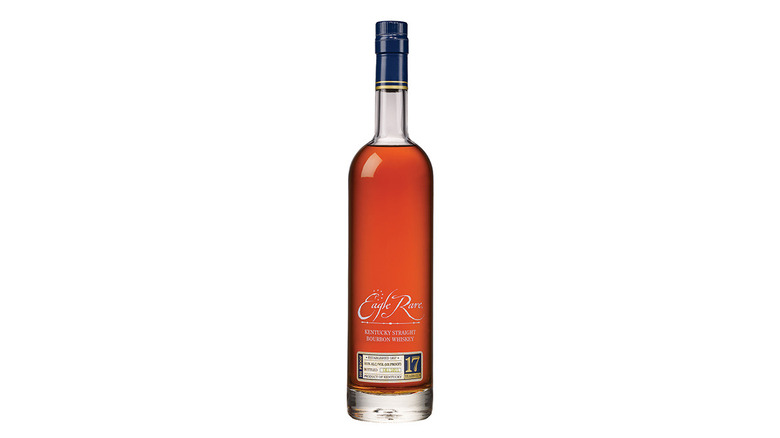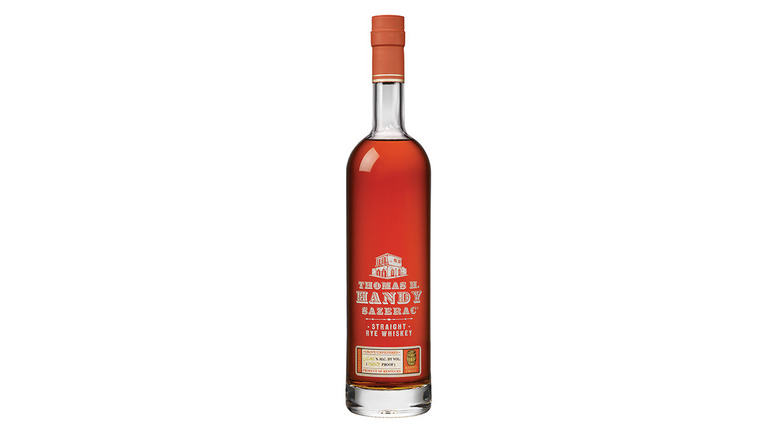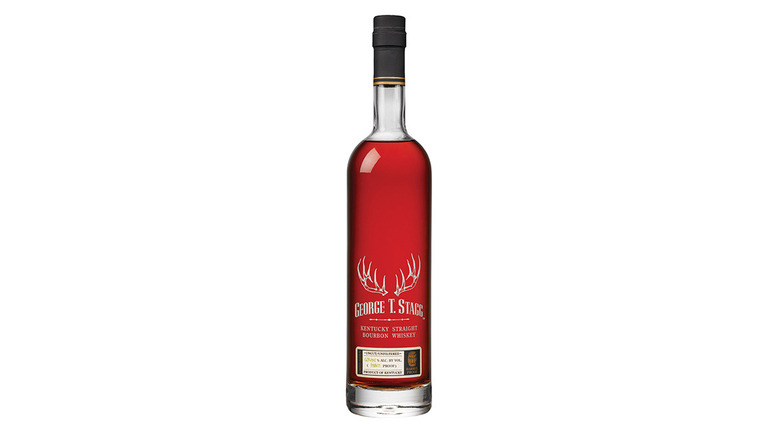Every Buffalo Trace Antique Collection 2022 Bottle, Ranked
Whiskey drinkers, we gather here today to rejoice. We recently got our hands on samples of the coveted 2022 Buffalo Trace Antique Collection. The elite roster always lands on the short list of whiskeys that can vie with the Van Winkle family for anticipated releases and this year's lineup is no exception.
Each of the five bottles carries a manufacturer's suggested retail price of $99, and none of them are obtainable at that cost. The BTAC bottles take off in value the second they're on the shelf, and you'd be a legendary adventurer to even find the liquor store that starts at a Franklin when it would be raising prices to four figures by the end of the day, making these immediately among the most expensive bottles of bourbon ever.
In our tasting, the 2022 lineup doesn't perfectly match the flavors the press release would have you expect, and it affects our ranking of the 2022 Buffalo Trace Antique Collection. Whiskey tasting is innately subjective, so consider this article not as a rebuttal to the expert profiles but more its grain of salt. What we can agree on is this spectacular lineup mostly lives up to its reputation.
5. William Larue Weller
After scents of vanilla, walnut, and sweet baked bread comes the lineup's most prevalent-tasting burn. When it passes, there's ... chestnuts? Buffalo Trace says leather, nutmeg, toffee, and vanilla, which isn't wrong but good luck distinguishing them.
Frankly, this one hurts, because Weller is a favorite with this table's designated taster. Weller Special Reserve is easy to love, yet William Larue Weller doesn't feel like fully realized potential. Regrettably, it's the least-improved in this collection, exceeding its very fine base by only moderate margins. If you grab it at $99, you'll be a happy Pappy-by-proxy drinker. But it's not a four-figure whiskey, and the Weller family, for all its price increases, boasts a number of very desirable bourbons under a grand.
We compared it alongside Special Reserve, which at 90 proof plays at a volume low enough to communicate the yield's complexity. By 124.7, what should be the adopted consigliere of the Pappy Van Winkle crew starts to outshout its own nuance. Yes, the green label sips like juice after this bold ABV, but the BTAC edition blurs into one loud note of sizzling caramel.
In fairness, a drop of water brings it down to earth, or an ice cube if you dare, as dilution helps this become more itself. Weller completists and wheated bourbon aficionados will want it, but if there's a bottle in this lineup for the flippers, we're crestfallen to report it was our highest hope here.
4. Sazerac 18-Year-Old
Woah. How often do you get to describe a whiskey as creative?
The fresh and citrusy nose of the Sazerac 18-Year-Old rye is the best yet: uncut grass, lemongrass, honeysuckle, star anise, and grapefruit are detected. If this weren't so much fun to drink it would have a great future as a cologne. At 90 proof, it's the lowest alcohol content of the BTAC line, but its character is figuratively intoxicating at overproof levels.
The taste is a big changeup from what the scent promises: briny, followed by tobacco, then something bitterly meaty, like an acrid char rather than a Maillard crust that just extends the limit of its welcome presence. This would pair beautifully with barbecued beef. There's almost something fermented and cultured in it like blue cheese or gochujang, and it's not unpleasant. Everything herein is rare in a whiskey, and more so in a rye. What an intriguing character Sazerac 18-Year-Old rye is. It's like the David Byrne or David Lynch of BTAC releases, or even some hypothetical third oddball David. The rye is fresh and strong, but wearing kid gloves for anyone who fears its usual pepper-punch intensity.
If you have the luck to capture this manticore in the wild, pop that top. This is a textbook rye every collector needs to find, but not one that should stay sealed on the shelf. It's a roller coaster ride, not an investment piece.
3. Eagle Rare 17-Year-Old
The nose is white wine and clover, but give the Eagle Rare 17-Year-Old several minutes to blow off that ethanol burn. Repeated tastings start off sharply like aspirin, then quickly hairpin to flourish as full-bodied oak and pepper. The rye is remarkably prominent, considering it uses Buffalo Trace's mash bill #1, which is the company's specifically low-rye one. Though 10% rye isn't the lowest, it makes itself surprisingly known at these levels. Perhaps because, compared with the 1 to 2% yearly evaporation that is typical, 70% of this batch evaporated during aging at double that rate. Entering the barrel at 125 proof, it was restored in bottling to the original 101 proof of the first release in 2002.
Noticeable in the transition between those two states is something plantlike but not quite vegetal: call it a lighter shade of earthiness. Although Buffalo Trace cites dark cherry and chocolate in the 2022 Eagle Rare 17-Year-Old, both have been more prevalent — even downright candylike — in previous years' pours. And with enough airflow swishing it around your mouth, you'll still detect almonds. Though less sweet than its official release description would indicate, it's a very satisfying bourbon indeed.
2. Thomas H. Handy Sazerac
They might have approximate names, but Thomas H. Handy Sazerac rye and Sazerac 18 wave to each other from different shores across an ocean of flavor. Handy's nose is a spicy Christmas rum punch with the almost ever-present cherry in whiskey. And it's 130.9 proof, a heavyweight compared to 90-proof 18's bantamweight.
Of all the beauties in this batch, Handy tastes the most like it smells: sweet, fruity, rich, and spicy. It passes the lips delivering greater depth on the same profile. This is the better rye of the two, even if it's hard to compare the one breaking the rules with this perfection of the standard issue. It practically tastes like a completed Manhattan — no vermouth or cherry required. Nice, dark chocolate tones support the rye spice without overshadowing it. You could quite happily make this bottle your only purchase of the collection and never look back.
Pour this one for a whiskey-drinking friend who insists they don't like rye, and it'll change their tune. If it doesn't ... well, they'll still be grateful for the chance to say authoritatively that rye's not their thing if the world's apex bottle fails to sway them. But don't be shy to finish their serving if they don't like it. Handy's greatness is too good to waste on unappreciative palates, and the drain would be a tragedy unto itself.
1. George T. Stagg
Bourbon fanatics were crestfallen upon learning that due to quality issues, there was no George T. Stagg last year for the first time in its two-decade run. (Buffalo Trace holds these releases to such standards that they'd rather frustrate through omission than failure.) Happily, it's back and exceeding those stringent standards. The 2022 is a bourbon with legs for days, which may have something to do with why, as in previous years, it's the best of the Antique Collection bunch. Sadly, this frequent top-ranking makes George T. Stagg the rarest of finds in an already impossible-to-get collection. An acidic rich nose greets you, but somehow it's the smoothest of the lot even in its aroma, high ABV or not. It offers all the kick of barrel-strength bourbon (138.7 proof!), yet somehow lacks an ethanol uppercut.
The sour mash is manifest and wonderful. There's a peppermint candy taste and a richer body promised by those thick legs. George T. Stagg 2022 is a truly beautiful bourbon whose smallest swallow lingers happily in your mouth, warming you with the slowest of fade-outs. If you want to know the worth of a whiskey, consider the quality of how long you can sit there happily between sips. You cannot possibly drink Stagg slowly enough, as you're only ever extending your pleasure and ruminations on how good it is. Pair this bourbon with your richest appetizers: devils on horseback, caviar canape, or anything else that vibrates with umami, whether fancy or not. The whiskey's the star here anyway.
